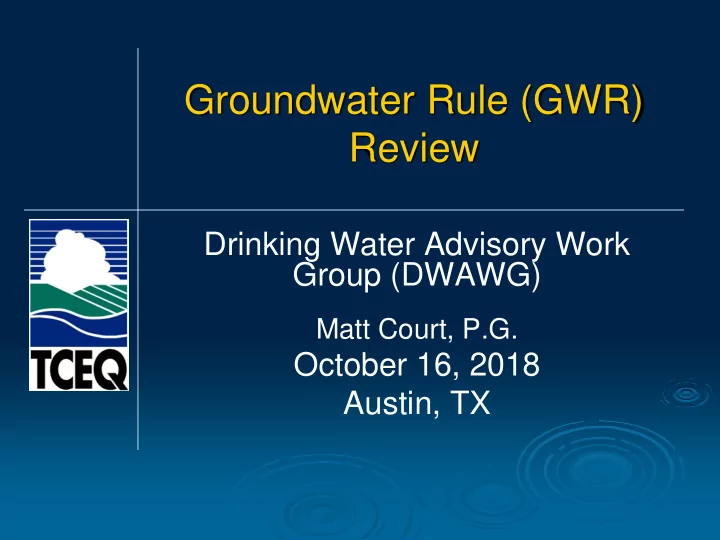

Groundwater Rule (GWR) Review Drinking Water Advisory Work Group (DWAWG) Matt Court, P.G. October 16, 2018 Austin, TX
GWR – Risk / Targeting Approach • Periodic Sanitary Surveys • Identify significant deficiencies • Triggered Source Water Monitoring • Identify fecal contamination • Corrective Action (CA) • Compliance Monitoring • Reporting
GWR Compliance Tracks There are two major tracks of the GWR. The first is a set of requirements that identify systems at risk of microbial contamination and require corrective actions to minimize the risk to fecal contamination. The second is for the systems that are actively treating their water to 4-Log standards in order to minimize the risk of fecal contamination in the distribution system. The second track is to ensure the treatment is functioning properly.
Sanitary Surveys / Comprehensive Compliance Investigations (CCI)
CCI Frequency • Community Water System: • every 3 years • Non-Community Water System: • every 5 years
8 Elements of a Sanitary Survey (CCI) • Source • Monitoring, reporting, data • Treatment verification • Distribution • Management and • Finished water operation storage • Operator • Pumps, facilities, compliance and controls
Triggered Source Monitoring (TSM)
TSM Applicability • Applies to all GW sources not providing 4-log (99.99%) treatment of viruses; source samples must be collected when coliform is present in distribution system. • TSM not required if: • distribution sample invalidated; or • linked to Distribution Deficiency. • Source sample must come from each source in operation and must be collected within 24 hours * Triggered Source Monitoring Plan * Timeframe – must notify if outside 24 hours
TSM – One-to-One • Triggered source monitoring is a one-to-one relationship between distribution positives and required source samples • For each distribution positive, at least 1 source sample must be collected from each well that was active at time of positive • Ex. PWS has 5 distribution positives; 5 source samples must be collected from each well that was in use at the time of the positive samples 9
Providers of Groundwater • Receiver PWS must notify Provider PWS within 24 hours of distribution TC+ • Providers must collect source sample within 24 hours • Providers must notify all Receivers of any fecal indicator positive result within 24 hours
Assessment Source Monitoring (ASM)
ASM • ASM may be required as a result of a Hydrogeological Sensitivity Assessment (HSA); HSA may determine that source is susceptible to fecal contamination • ASM may be required as a result of the rule exception process • ASM may be required as a CA • ASM sample may be used for TSM if collected within 24 hours of notification of distribution positive • TSM sample may be used for ASM as well 12
Corrective Action (CA)
CA – 30 TAC §290.116 • TCEQ requires a CA when fecal indicator ( E. coli ) is present in GW sources through TSM or ASM sampling, or if a significant deficiency (SD) is identified • 6 possible CAs
Corrective Actions 30 TAC §290.116(b)(5) • PWS with a significant deficiencies or source water fecal indicator positive, must implement one or more of the following: 1. Correct all significant deficiencies 2. Provide alternate source of water 3. Eliminate source of contamination 4. Provide 4-log treatment of viruses
Additional Corrective Actions 1. Disinfect well in accordance with AWWA procedures 2. Assessment Source Monitoring
4-log Treatment as CA • 4-log treatment is an effective tool under the GWR • This gives systems the opportunity to continue using a well that is susceptible to fecal contamination through additional treatment
Concentration Time (CT) Studies 4-log Treatment of Viruses
4-log Treatment • 99.99% inactivation/removal of viruses • chlorine (chlorine gas or hypochlorite) • chlorine dioxide • ozone • chloramines (possibly) • It should be noted that a system must maintain a free (0.2 mg/L) or total chlorine (0.5 mg/L) residual in the distribution system • The GWR does not require 4-log treatment for all groundwater sources • Requires compliance monitoring of disinfectant
Why would a system choose 4-log treatment? • GW system may already provide, or have the capability to provide, 4-log treatment through its existing treatment process • The system does not want to have to conduct triggered source monitoring related to a positive distribution sample • (useful for systems with a lot of wells) • May be required by the TCEQ as a CA
How do Systems Apply for Approval of 4-log treatment? • Cover letter including reason for submittal (CA compliance requirement or to be exempt from triggered source monitoring) • Complete Groundwater Minimum Specified Residual (GWMSR) Template http://www.tceq.texas.gov/drinkingwater/swmor/ swmor/ct_info • List all sources supplying the entry point • Schematic including well ID numbers, flow, units, injection points, & sample point location 21
Groundwater CT Template
Approval of CT Study • Technical Review and Oversight Team (TROT) will notify the system, in writing, on approval status for 4-log treatment • Includes compliance monitoring conditions required by the system in order to achieve credit • A minimum specified residual (MSR) will be set by the TCEQ and must be maintained prior to the first customer
Approval of CT Study (cont.) • GW 4-log MSR data is required to be maintained on a daily basis • Including nights, weekends, and holidays • This is in addition to the GW/PW MOR (production), the DLQOR, and any other rule requirements
Conclusion • GWR is valuable regulation; estimated to prevent over 43,000 waterborne illnesses per year. • 4-log treatment and Triggered Source Monitoring Plan options can reduce triggered source (raw) samples. • Contact the TCEQ! Communication between the TCEQ, your purchasers and wholesalers is vital.
Financial, Managerial and Technical (FMT) Assistance If you would like to arrange for free financial, managerial, or technical assistance, contact our Financial, Managerial, and Technical (FMT) program team: FMT@tceq.texas.gov https://www.tceq.texas.gov/drinkingwater/fmt (512) 239-4691
Water Supply Division / Drinking Water Assessment Team: 512-239-4691 Drinking Water Watch: www.tceq.texas.gov/goto/dww Matt Court – Matt.Court@tceq.texas.gov 512-239-5844
Recommend
More recommend